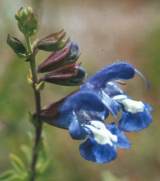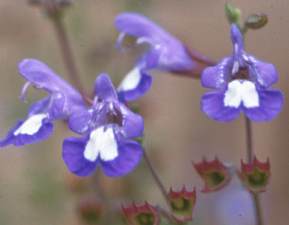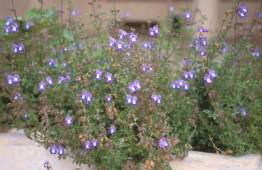Salvia muirii
Salvia muirii L. Bol.
Family: Lamiaceae
Common names: Muir's wild sage (Eng.), wildesalie (Afr.)
Introduction
There are many fascinating plants in the sage family. As garden plants, some may be more interesting than beautiful, but Salvia muirii, with its large intense blue flowers throughout summer, performs to perfection. This beautiful plant is fairly easy to grow in a pot, rockery or garden bed.

Description
Description
Salvia muirii is a small, twiggy, evergreen shrub that grows only about 30 cm high. It has a woody stem and an underground rootstock that gives it the ability to resprout easily after fires. The leaves are leathery, oval in shape and light green to almost grey in colour. When crushed, they are slightly sticky and release a light scent that is reminiscent of Vicks.

The flowers appear from mid-summer until autumn (December-March), opening in pairs at the tip of each stem. The stems continue to grow forming new buds, while the older flowers fall off and only their dark red bracts remain. The flowers, which are quite large for such a small plant, are blue with a characteristic white mark on the lower lip. The flower shape is typical of Salvia, with the upper lip hooded or closed while the lower lip opens wide and flat. The small black spherical seeds sit deep inside the remaining flower bracts and are released about a month after flowering, when the bracts are dry.

Distribution and habitat
Distribution description
Finding Salvia muirii in the veld is not so easy, for the natural populations are restricted to only a few localities in the southern Cape. Here they grow in dry fynbos in sandy soils along a narrow strip following the northern foothills of the Langeberg near Riversdale to the Great Brak River near Mossel Bay.
Derivation of name and historical aspects
History
The first collection of plants of Salvia muirii was made in 1915 by Dr John Muir, an enthusiastic plant collector who lived in the southern Cape and who contributed greatly to our knowledge of the plants of this area.
In South Africa there are more than thirty species of Salvia. Worldwide there are between 800 and 900 species, widely distributed throughout the temperate and tropical regions of the northern and southern hemispheres. The best-known salvia is sage, Salvia officinalis, from the Mediterranean, which has been used since ancient times as a powerful healing plant and strong culinary herb. The name salvia comes from the Latin salvere, which means to be in good health, to cure and to save.
Ecology
Ecology
Like so many other salvias, Salvia muirii is popular with bees in the garden.
Growing Salvia muirii
Grow
Salvia muirii is a delight to have in the garden, particularly during summer when it is covered with flowers. This little woody shrub is also long-lived, drought resistant and almost pest free. It is easy to grow with the most important requirements being full sun and well-drained soil. To encourage compact bushy growth it should be pruned lightly throughout the year and fed regularly with an organic fertilizer.

At Kirstenbosch we grow a particularly dark blue form of Salvia muirii that will be released soon as a special selection. This good form of Salvia muirii was collected and introduced into horticulture by Ernst van Jaarsveld, a great plantsman with a particular interest in salvias.
New plants of Salvia muirii can be propagated from cuttings or seed. The best time to make cuttings is in spring or summer, using the fresh, new growth. The plants also produce plenty of seed that is best sown during autumn or winter. The seed germinates within about 10 days and produces strong, vigorous seedlings that often flower in their first year.
References
- Bremness, Lesley, 1988, The Complete Book of Herbs, Dorling Kiendersley Book
- van Jaarsveld, Ernst, Salvia muirii-'n Nuwe Blou Salie, Veld en Flora, December 1983
- Flora of Southern Africa, 1985, Volume 28 Part 4
Credits
Liesl van der Walt
Kirstenbosch National Botanical Garden
February 2002
Plant Attributes:
Plant Type: Shrub
SA Distribution: Western Cape
Soil type: Sandy, Loam
Flowering season: Late Summer, Autumn
PH: Acid, Neutral
Flower colour: Blue, White, Mauve/Lilac
Aspect: Full Sun
Gardening skill: Average
Special Features:
Horticultural zones








Rate this article
Article well written and informative
Rate this plant
Is this an interesting plant?
Login to add your Comment
Back to topNot registered yet? Click here to register.